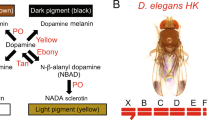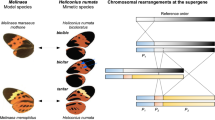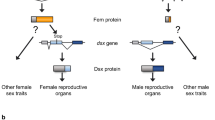Abstract
The gain, loss or modification of morphological traits is generally associated with changes in gene regulation during development. However, the molecular bases underlying these evolutionary changes have remained elusive. Here we identify one of the molecular mechanisms that contributes to the evolutionary gain of a male-specific wing pigmentation spot in Drosophila biarmipes, a species closely related to Drosophila melanogaster. We show that the evolution of this spot involved modifications of an ancestral cis-regulatory element of the yellow pigmentation gene. This element has gained multiple binding sites for transcription factors that are deeply conserved components of the regulatory landscape controlling wing development, including the selector protein Engrailed. The evolutionary stability of components of regulatory landscapes, which can be co-opted by chance mutations in cis-regulatory elements, might explain the repeated evolution of similar morphological patterns, such as wing pigmentation patterns in flies.
This is a preview of subscription content, access via your institution
Access options
Subscribe to this journal
Receive 51 print issues and online access
$199.00 per year
only $3.90 per issue
Buy this article
- Purchase on Springer Link
- Instant access to full article PDF
Prices may be subject to local taxes which are calculated during checkout






Similar content being viewed by others
References
Carroll, S. B., Grenier, J. K. & Weatherbee, S. D. From DNA to Diversity: Molecular Genetics and the Evolution of Animal Design 2nd edn (Blackwell Science, Malden, Massachusetts, 2004)
Davidson, E. H. Genomic Regulatory Systems: Development and Evolution (Academic, San Diego, 2001)
Stern, D. L. Evolutionary developmental biology and the problem of variation. Evolution 54, 1079–1091 (2000)
Averof, M. & Patel, N. H. Crustacean appendage evolution associated with changes in Hox gene expression. Nature 388, 682–686 (1997)
Gompel, N. & Carroll, S. B. Genetic mechanisms and constraints governing the evolution of correlated traits in drosophilid flies. Nature 424, 931–935 (2003)
Yoon, H. S. & Baum, D. A. Transgenic study of parallelism in plant morphological evolution. Proc. Natl Acad. Sci. USA 101, 6524–6529 (2004)
Sucena, E. & Stern, D. L. Divergence of larval morphology between Drosophila sechellia and its sibling species caused by cis-regulatory evolution of ovo/shaven-baby. Proc. Natl Acad. Sci. USA 97, 4530–4534 (2000)
Shapiro, M. D. et al. Genetic and developmental basis of evolutionary pelvic reduction in threespine sticklebacks. Nature 428, 717–723 (2004)
Stern, D. L. A role of Ultrabithorax in morphological differences between Drosophila species. Nature 396, 463–466 (1998)
Wang, R. L., Stec, A., Hey, J., Lukens, L. & Doebley, J. The limits of selection during maize domestication. Nature 398, 236–239 (1999)
Wittkopp, P. J., Vaccaro, K. & Carroll, S. B. Evolution of yellow gene regulation and pigmentation in Drosophila . Curr. Biol. 12, 1547–1556 (2002)
Wang, X. & Chamberlin, H. M. Multiple regulatory changes contribute to the evolution of the Caenorhabditis lin-48 ovo gene. Genes Dev. 16, 2345–2349 (2002)
Belting, H. G., Shashikant, C. S. & Ruddle, F. H. Modification of expression and cis-regulation of Hoxc8 in the evolution of diverged axial morphology. Proc. Natl Acad. Sci. USA 95, 2355–2360 (1998)
Bock, I. R. & Wheeler, M. R. in Studies in Genetics (ed. Wheeler, M. R.) 1–102 (Univ. of Texas, Austin, 1972)
Majerus, M. E. N. Melanism: Evolution in Action (Oxford Univ. Press, Oxford, 1998)
Singh, B. N. & Chatterjee, S. Greater mating success of Drosophila biarmipes males possessing an apical dark black wing patch. Ethology 75, 81–83 (1987)
Kopp, A. & True, J. R. Evolution of male sexual characters in the oriental Drosophila melanogaster species group. Evol. Dev. 4, 278–291 (2002)
True, J. R., Edwards, K. A., Yamamoto, D. & Carroll, S. B. Drosophila wing melanin patterns form by vein-dependent elaboration of enzymatic prepatterns. Curr. Biol. 9, 1382–1391 (1999)
Wittkopp, P. J., True, J. R. & Carroll, S. B. Reciprocal functions of the Drosophila Yellow and Ebony proteins in the development and evolution of pigment patterns. Development 129, 1849–1858 (2002)
Chia, W. et al. Molecular analysis of the yellow locus of Drosophila . EMBO J. 5, 3597–3605 (1986)
Geyer, P. K. & Corces, V. G. Separate regulatory elements are responsible for the complex pattern of tissue-specific and developmental transcription of the yellow locus in Drosophila melanogaster . Genes Dev. 1, 996–1004 (1987)
Kopp, A. & True, J. R. Phylogeny of the oriental Drosophila melanogaster species group: a multilocus reconstruction. Syst. Biol. 51, 786–805 (2002)
Schawaroch, V. Phylogeny of a paradigm lineage: the Drosophila melanogaster species group (Diptera: Drosophilidae). Biol. J. Linn. Soc. 76, 21–37 (2002)
Garcia-Bellido, A., Ripoll, P. & Morata, G. Developmental compartmentalization of the wing disk of Drosophila . Nat. New Biol. 245, 251–253 (1973)
Blair, S. S. Engrailed expression in the anterior lineage compartment of the developing wing blade of Drosophila . Development 115, 21–33 (1992)
Solano, P. J. et al. Genome-wide identification of in vivo Drosophila Engrailed-binding DNA fragments and related target genes. Development 130, 1243–1254 (2003)
Wittkopp, P. J., Williams, B. L., Selegue, J. E. & Carroll, S. B. Drosophila pigmentation evolution: Divergent genotypes underlying convergent phenotypes. Proc. Natl Acad. Sci. USA 100, 1808–1813 (2003)
Llopart, A., Elwyn, S., Lachaise, D. & Coyne, J. A. Genetics of a difference in pigmentation between Drosophila yakuba and Drosophila santomea . Evolution 56, 2262–2277 (2002)
Russo, C. A., Takezaki, N. & Nei, M. Molecular phylogeny and divergence times of drosophilid species. Mol. Biol. Evol. 12, 391–404 (1995)
Powell, J. R. Progress and Prospects in Evolutionary Biology: the Drosophila Model (Oxford Univ. Press, New York, 1997)
Hardy, D. E. Diptera: Cyclorrhapha II, Series Schizophora, Section Acalypterae I, Family Drosophilidae (Univ. of Hawaii Press, Honolulu, 1965)
De Celis, J. F. Pattern formation in the Drosophila wing: The development of the veins. BioEssays 25, 443–451 (2003)
Blair, S. S. Compartments and appendage development in Drosophila . BioEssays 17, 299–309 (1995)
Gonzalez, P., Rao, P. V., Nunez, S. B. & Zigler, J. S. Jr Evidence for independent recruitment of zeta-crystallin/quinone reductase (CRYZ) as a crystallin in camelids and hystricomorph rodents. Mol. Biol. Evol. 12, 773–781 (1995)
Monod, J. Le Hasard et la Nécessité. Essai sur la Philosophie Naturelle de la Biologie Moderne (Éditions du Seuil, Paris, 1970)
Kauffman, S. A. At Home in the Universe: the Search for the Laws of Self-organization and Complexity (Oxford Univ. Press, New York, 1995)
Wheeler, M. R. & Clayton, F. E. A new Drosophila culture technique. Drosophila Inf. Serv. 40, 98 (1965)
Ashburner, M. Drosophila. A Laboratory Manual (Cold Spring Harbor Laboratory Press, Cold Spring Harbor, New York, 1989)
Spradling, A. C. & Rubin, G. M. Transposition of cloned P elements into Drosophila germ line chromosomes. Science 218, 341–347 (1982)
Miller, D. F., Holtzman, S. L. & Kaufman, T. C. Customized microinjection glass capillary needles for P-element transformations in Drosophila melanogaster . Biotechniques 33, 366–375 (2002)
Flybase. http://flybase.bio.indiana.edu.
Barolo, S., Carver, L. A. & Posakony, J. W. GFP and β-galactosidase transformation vectors for promoter/enhancer analysis in Drosophila . Biotechniques 29, 726–732 (2000)
Celniker, S. E. et al. Finishing a whole-genome shotgun: release 3 of the Drosophila melanogaster euchromatic genome sequence. Genome Biol. 3, RESEARCH0079 (2002)
Human Genome Sequencing Center. Drosophila genome project. http://www.hgsc.bcm.tmc.edu/projects/drosophila/ (2002).
Schendel, P. F. in Current Protocols in Molecular Biology (eds Ausubel, F. M. et al.) 16.7.1–16.7.7 (Wiley, New York, 1993)
Bock, I. R. Current status of the Drosophila melanogaster species-group (Diptera). Syst. Entomol. 5, 341–356 (1980)
Mayor, C. et al. VISTA: Visualizing global DNA sequence alignments of arbitrary length. Bioinformatics 16, 1046–1047 (2000)
Remsen, J. & O'Grady, P. Phylogeny of Drosophilinae (Diptera: Drosophilidae), with comments on combined analysis and character support. Mol. Phylogenet. Evol. 24, 249–264 (2002)
Acknowledgements
We thank J. True, C. E. Nelson, C. M. Walsh and C. T. Hittinger for technical advice; J. True, S. Blair and members of the Carroll laboratory for discussions; B. L. Williams and J. Yoder for critical comments on the manuscript; S. Castrezana and T. Markow (Tucson Drosophila Stock Center) for providing Drosophila stocks; J. P. Gruber for the Euxesta sample; and S. Barolo for the pH Stinger vector. N.G. was funded by an EMBO long-term postdoctoral fellowship; B.P. and N.G. are recipients of a Philippe Foundation fellowship. The project was supported by the Howard Hughes Medical Institute (S.B.C.).
Author information
Authors and Affiliations
Corresponding author
Ethics declarations
Competing interests
The authors declare that they have no competing financial interests.
Supplementary information
Supplementary Figure 1
Sequence alignment of the wing enhancers of D. melanogaster, D. biarmipes and D. pseudoobscura. (DOC 44 kb)
Supplementary Table 1
Sequences of oligonucleotides used for reporter constructs. (DOC 30 kb)
Rights and permissions
About this article
Cite this article
Gompel, N., Prud'homme, B., Wittkopp, P. et al. Chance caught on the wing: cis-regulatory evolution and the origin of pigment patterns in Drosophila. Nature 433, 481–487 (2005). https://doi.org/10.1038/nature03235
Received:
Accepted:
Issue Date:
DOI: https://doi.org/10.1038/nature03235
This article is cited by
-
The evolution and mutational robustness of chromatin accessibility in Drosophila
Genome Biology (2023)
-
Unraveling regulatory divergence, heterotic malleability, and allelic imbalance switching in rice due to drought stress
Scientific Reports (2021)
-
Tempos and modes of collectivity in the history of life
Theory in Biosciences (2021)
-
The color pattern inducing gene wingless is expressed in specific cell types of campaniform sensilla of a polka-dotted fruit fly, Drosophila guttifera
Development Genes and Evolution (2021)
-
Variable levels of drift in tunicate cardiopharyngeal gene regulatory elements
EvoDevo (2019)
Comments
By submitting a comment you agree to abide by our Terms and Community Guidelines. If you find something abusive or that does not comply with our terms or guidelines please flag it as inappropriate.



